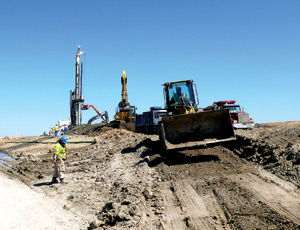A massive,1.7-million-cu-yd, deep-soil-mixing project is powering up in eastern New Orleans, and veterans of the technique say it’s probably the largest such project ever undertaken.

Joint-venture partners Archer Western Contractors, Atlanta, Ga., and Alberici Enterprises, Overland, Mo., are strengthening a levee maintained by the U.S. Army Corps of Engineers so it can be increased in height to +28 ft from its current +17 ft without widening the base as much as normally would be required. The site is constrained on one side by environmentally sensitive wetlands.
Dave Druss, the geotechnical engineer performing technical oversight for the Corps who also worked on Boston’s Central Artery Tunnel, says the Big Dig’s deep-soil mixing totaled “only 650,000 to 700,000 cu yds.”
Wesley Schmutzler, project manager for soil-mixing specialty subcontractor Treviicos Corp., Boston, expects to be soon working six rigs round-the-clock, reinforcing the 5.3-mile-long designated area. The soil mixing extends to -67 ft deep and varies in width from 54 ft to 98 ft, depending upon stratigraphy.
“We’re stretching the limits of the industry here,” says Richmond Kendrick, deputy for program execution with the Corps’ Hurricane Protection Office.
Well before the Corps awarded the $3.1-million base portion of the $300-million early-contractor-involvement contract last July, Kendrick says the owner knew the job would require a joint venture. “Industry told us they’d never done anything this large before,” he says.
The Archer/Alberici joint venture finished the first of five mix validations in March and plans to be up to full mixing speed by May. “Validation is not to determine if it can be done, but what the right mix is for this site,” says Chester Ashley, Corps resident engineer.
The goal of the work is to bring the levee to a design that will withstand storm surges of 30 ft or more—“Like we had with Hurricane Katrina,” says Druss. The existing levee base is 30 ft wide. The new levee will be about 120 ft at the toe. “Normally, we would just build it up with soil,” Druss says. To maintain a 1:3 slope at the new, higher elevation, the base must be wider, but site constraints limit base growth to a 1:2.85 ratio.
“If we make the slope that steep, we might have a rotational failure mode, a potential shear failure,” Druss says. Study revealed two options: a concrete T-wall or building up with earth reinforced by deep-soil mixing. “Deep-soil mixing is cheaper,” Druss says. “Plus, people can walk over [the levees] and enjoy them.”
All six rigs create the same end result: a series of 10-ft-wide “elements.” These are basically two, 5¼-ft-diameter, side-by-side columns linked to create variable-width concrete panels spaced 15½ ft from center line to center line, Druss says.
The mixers are fixed with rotary heads and steel rods that feed grout through each head’s center, explains Schmutzler. “We start injecting grout right from the surface [all] the way down,” he says. Engine power packs depress the head, spin the mixer panels and inject the slurry, creating a thick paste. “This paste takes quite a while to set up,” Schmutzler says. “Our target strength is 120 psi at 28 days.” Treviicos installs two primary elements, then returns to install a secondary element in the interstitial space. The process creates a contiguous, reinforced area.
“Probably the most challenging part is the schedule,” says Druss, referring to the June 1, 2011, deadline to bring the system to 100-year levels of protection. “We need multiple rigs working round-the-clock six days a week, so we have to make sure there is a steady supply of cement, the rigs are well-maintained, and we have a supply of spare parts, because the equipment comes from Italy and Japan.”
The deep-soil-mixing portion must be complete by next spring. The overall contract must be delivered by June 1, 2011, and includes 1.6 million cu yd of clay topping, a short section of concrete T-wall at a pump station and another section that will tie the project into the nearby Lake Borgne Inner Harbor Navigation Canal storm-surge barrier.



Post a comment to this article
Report Abusive Comment